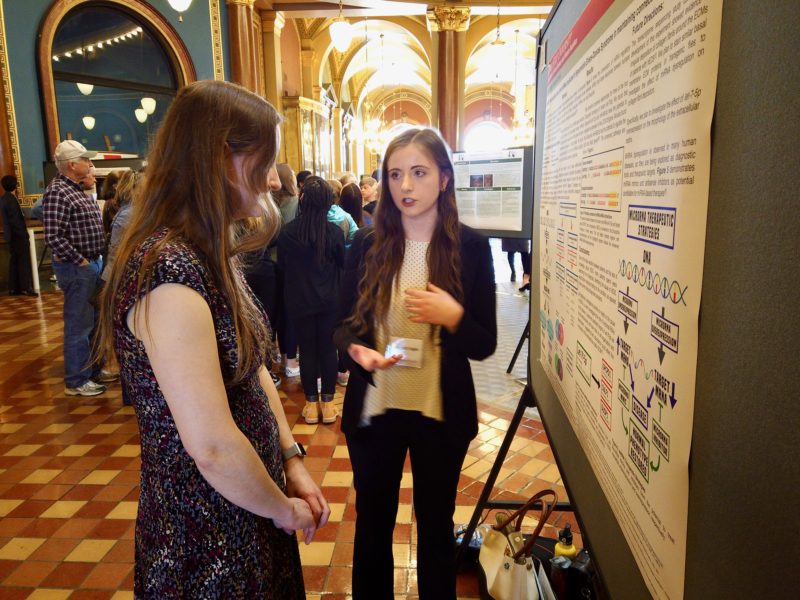
Diagnosis Inspires Purpose and Service
By: Ann Y. Robinson
Image by Barb McBreen
Scarlett Eagle speaks forcefully as she describes the intricate genetics shared by humans and fruitflies as explained in a poster about her research. She’s examining a class of small molecules that may be linked to a number of genetic diseases – including hers.
“One in 10 Americans has a rare disease. Since this doesn’t involve a lot of people, they often go unrecognized,” says Eagle. “That makes them seem even more rare, so there isn’t much money for medical research into cures or treatments. It’s frustrating.”As she talks about her work – and some of the activities she’s been a catalyst for – it’s easy to understand why she has earned notice on campus. Eagle, a senior in genetics, was selected to present her research at the Iowa Capitol and has received a number of awards, including a prestigious Roy J. Carver Trust Scholarship to support students overcoming significant challenges.
A SENSE OF PURPOSE
Her challenges aren’t immediately apparent, but they’re with Eagle every moment. She has a rare disease known as Hypermobile Ehlers-Danlos Syndrome (hEDS), an inherited disorder that affects the connective tissue and collagen in skin, joints and blood vessel walls. Those who have the syndrome have overly flexible joints and stretchy, fragile skin. Other symptoms can include fatigue, dizziness and severe joint pain.
It was the joint pain that sent Eagle and her parents looking for answers when she was 12. As a budding competitive cheerleader, it was a benefit to be unusually flexible, but she was starting to have pain that doctors couldn’t explain. It took several years before a physical therapist suggested she might have Ehlers-Danlos Syndrome. That diagnosis was soon confirmed.
“Unfortunately, there aren’t any treatments,” says Eagle. “Like so many rare diseases, you mostly treat the symptoms. I have to take a lot of medicines. Sometimes they help, and sometimes the side effects just make things worse.”
Eagle says there’s a plus side, though. “Until I was diagnosed, I didn’t really know what I wanted to do with my life.”
After struggling to be taken seriously by medical professionals before her diagnosis, Eagle wanted to make the world a better place for those with rare conditions.
As a junior, she worked with her Pre-Med Club to host Iowa State’s first Rare Disease Day. They invited students to share information and stories about their rare diseases. Nearly 300 students participated, overwhelming the event space.
“That strong interest gave me the idea to create a Rare Disease Awareness Club to spread awareness on campus year-round,” Eagle says. Each month, the club spotlights a different disease through a presentation, display at the library and a feature in the club’s newsletter, which Eagle edits.
“Scarlett has a passion for raising awareness of rare diseases and advocating for research into underlying mechanisms and, ultimately, the development of cures,” says Marna Yandeau-Nelson (Ph.D. ’05 genetics), Eagle’s academic adviser and an assistant professor in the Department of Genetics, Development and Cell Biology. “I have been very impressed by Scarlett’s commitment, organization and her ability to communicate to make an event like Rare Disease Day happen.”
Such extracurriculars represent a lot of extra work for a student with chronic symptoms that sap health and energy. Even so, Eagle says it’s worth it: “I have always wanted to use my experiences to help others.”
SOMEDAY IS TODAY
Since entering college with the goal to become a doctor, Eagle was slowly pulled towards research.
Last year, Eagle had the serendipitous chance to work in the lab of Elizabeth McNeill (’02 biology), an assistant professor in the Department of Food Science and Human Nutrition. McNeill studies how genes influence tissue development and maintenance – including how a class of small molecules, known as microRNAs, help regulate expression of genes, which may be linked to a number of genetic diseases.
“Scarlett told me about her experience living with Ehlers-Danlos syndrome and her goal to someday be able to research the disease,” says McNeill. “We discussed that it didn’t need to be someday, and I suggested we look into microRNAs’ potential role in her disorder. Since then, we’ve been working together to examine Drosophila (fruit flies) as a possible model of the genetic mechanisms underlying the disease. Scarlett has brought amazing energy and self-initiative to this new research.”
Eagle will graduate next fall. She has plenty of work – and challenges – ahead to get there. In the meantime, she is already thinking about Ph.D. programs where she will pursue a career resesarching rare conditions.
“Scarlett has excelled in so many aspects of her academic career so far,” says adviser Yandeau-Nelson. “She doesn’t let her disease hold her back, but instead she uses it as a fuel to be successful.”



